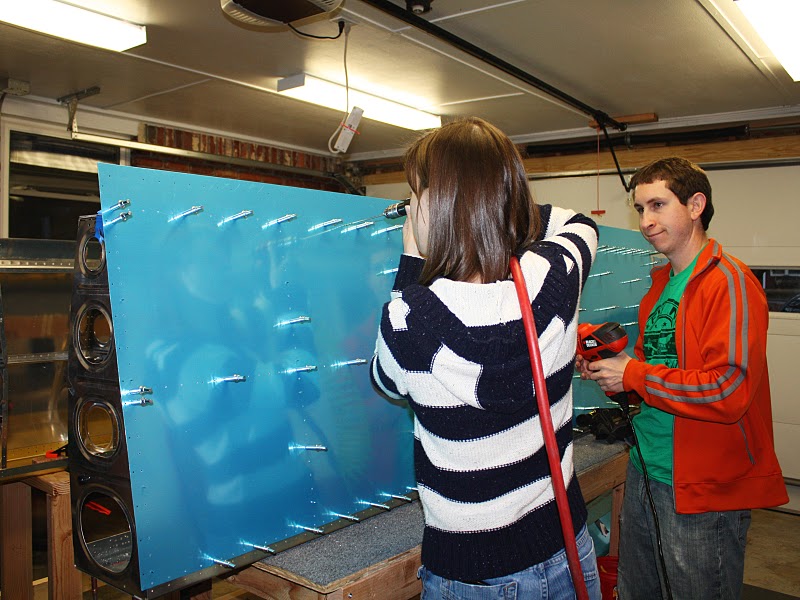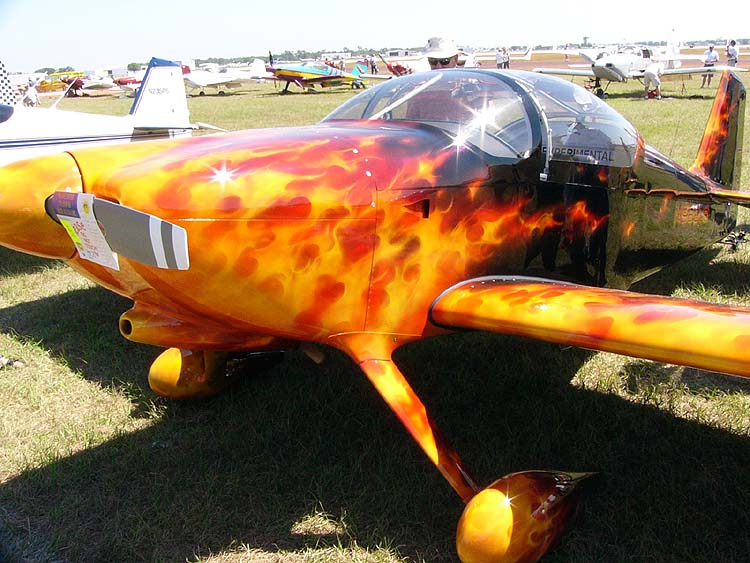|
Vans RV-10
The Van's Aircraft RV-10 is a four-seat, single-engine, low-wing homebuilt airplane sold in kit form by Van's Aircraft. It is the first four-seat airplane in the popular RV series.Vandermeullen, Richard: ''2011 Kit Aircraft Buyer's Guide'', Kitplanes, Volume 28, Number 12, December 2011, page 74. Belvoir Publications. The RV-10 first flew on 29 May 2003, and the first kit parts were delivered to a customer in September 2003. As of November 2022, 1,010 RV-10s have been completed and flown. Design and development The architect of the line of Van's aircraft, Richard VanGrunsven, designed the RV-10 to satisfy a market demand for a four-seat version of the popular RV series aircraft. The RV-10 was designed from the start as a touring aircraft and as such it forgoes the aerobatic capabilities and the lighter handling common to the aircraft in the RV line from the RV-3 to RV-8. Instead the RV-10 design focuses on greater stability and payload.Bayerl, Robby; Martin Berkemeier ... [...More Info...] [...Related Items...] OR: [Wikipedia] [Google] [Baidu] |
Homebuilt Aircraft
Homebuilt aircraft, also known as amateur-built aircraft or kit planes, are constructed by persons for whom this is not a professional activity. These aircraft may be constructed from "scratch", from plans, or from assembly kits.Armstrong, Kenneth: ''Choosing Your Homebuilt - the one you will finish and fly! Second Edition'', pp. 39–52. Butterfield Press, 1993. Peter M Bowers: ''Guide to Homebuilts - Ninth Edition''. TAB Books, Blue Ridge Summit PA, 1984. Overview In the United States, Brazil, Australia, New Zealand and South Africa, homebuilt aircraft may be licensed Experimental under FAA or similar local regulations. With some limitations, the builder(s) of the aircraft must have done it for their own education and recreation rather than for profit. In the U.S., the primary builder can also apply for a repairman's certificate for that airframe. The repairman's certificate allows the holder to perform and sign off on most of the maintenance, repairs, and inspections themsel ... [...More Info...] [...Related Items...] OR: [Wikipedia] [Google] [Baidu] |
Ballistic Parachute
A ballistic parachute, ballistic reserve parachute, or emergency ballistic reserve parachute, is a parachute ejected from its casing by a small explosion, much like that used in an ejection seat. The advantage of the ballistic parachute over a conventional parachute is that it ejects the parachute canopy (oftentimes via a small rocket), causing it to open rapidly, this makes it ideal for attaching to light aircraft, hang gliders and microlights, where an emergency may occur in close proximity to the ground. In such a situation, a conventional parachute would not open quickly enough. In 1982, Comco Ikarus developed the FRS rocket-launched parachute system for its ultralight and hanglider aircraft. In 1998, Cirrus Aircraft (then known as Cirrus Design) provided the first ballistic parachutes as standard equipment on their line of type-certified aircraft, the Cirrus SR20; and in 2016, the company delivered the Cirrus Vision SF50, the first jet aircraft with a ballistic parachute. S ... [...More Info...] [...Related Items...] OR: [Wikipedia] [Google] [Baidu] |
2000s United States Civil Utility Aircraft
S, or s, is the nineteenth letter in the Latin alphabet, used in the modern English alphabet, the alphabets of other western European languages and others worldwide. Its name in English is ''ess'' (pronounced ), plural ''esses''. History Origin Northwest Semitic šîn represented a voiceless postalveolar fricative (as in 'ip'). It originated most likely as a pictogram of a tooth () and represented the phoneme via the acrophonic principle. Ancient Greek did not have a phoneme, so the derived Greek letter sigma () came to represent the voiceless alveolar sibilant . While the letter shape Σ continues Phoenician ''šîn'', its name ''sigma'' is taken from the letter '' samekh'', while the shape and position of ''samekh'' but name of ''šîn'' is continued in the '' xi''. Within Greek, the name of ''sigma'' was influenced by its association with the Greek word (earlier ) "to hiss". The original name of the letter "sigma" may have been ''san'', but due to the compli ... [...More Info...] [...Related Items...] OR: [Wikipedia] [Google] [Baidu] |
Sling Aircraft Sling TSi
The Sling TSi is a South African four-seat, single-engine, low-wing homebuilt aircraft sold in kit form by Sling Aircraft of Johannesburg South. It was developed from the Sling 4. The Sling TSi first flew in 2018, with kits being shipped to builders in fall 2018. Design and development The aircraft was developed in 2018. The Sling TSi is an all-metal, low-wing, fixed tricycle gear homebuilt aircraft. The airplane is equipped with the new Rotax 915iS engine and was the inspiration for the designation of TSi. Parts of the wings and fuselage were reinforced and outfitted with flush riveting for increased strength and reduced drag over the Sling 4. The UK Light Aircraft Association has limited the airframe safe life to 1600 hours. Operational history The first Sling TSi in the USA was shown at EAA AirVenture Oshkosh in 2018. In a review for ''KitPlanes'', writer Paul Dye said, "...it lives up to its design goals. We flew with four full sized adults from a field with a densit ... [...More Info...] [...Related Items...] OR: [Wikipedia] [Google] [Baidu] |
Cirrus SR20
The Cirrus SR20 is an American piston-engined, four- or five-seat composite material, composite monoplane built since 1999 by Cirrus Aircraft of Duluth, Minnesota. The aircraft is the company's earliest type certificate, type-certified model, earning certification in 1998. It was the first production general aviation (GA) aircraft equipped with a Cirrus Airframe Parachute System, parachute to lower the airplane safely to the ground after a loss of control, structural failure, or midair collision. The SR series was also the first mass-manufactured light aircraft with all-composite construction and glass cockpit, flat-panel avionics. The SR20 was developed into the Cirrus SR22, which was introduced in 2001 and is the list of most-produced aircraft, most-produced GA aircraft of the 21st century. Design and development The SR20 mock-up was unveiled in 1994. The aircraft first flew on 21 March 1995 and Federal Aviation Administration, FAA certification was achieved on 23 October 19 ... [...More Info...] [...Related Items...] OR: [Wikipedia] [Google] [Baidu] |
Cirrus SR22
The Cirrus SR22 is a single-engine four- or five-seat composite aircraft built from 2001 by Cirrus Aircraft of Duluth, Minnesota. It is a development of the Cirrus SR20, with a larger wing, higher fuel capacity, and a more powerful, 310-horsepower (231 kW) engine. The SR22 series has been the world's best-selling general aviation (GA) airplane every year since 2003. With 6,149 units delivered from 2001–19, and in combination with the SR20, a total of 7,645, it is the most-produced GA aircraft of the 21st century, and is the single most-produced GA aircraft made from composite material, accounting for over 30% of the entire piston aircraft market. The Cirrus SR22 is equipped with a whole-plane emergency recovery parachute system: the Cirrus Airframe Parachute System (CAPS). This has contributed to its market success and has given it the nickname "the plane with the parachute". Design and development The SR22, certified in November 2000, is a more powerful version ... [...More Info...] [...Related Items...] OR: [Wikipedia] [Google] [Baidu] |
Cessna 400
The Cessna 400, marketed as the Cessna TTx, is a single-engine, fixed-gear, low-wing general aviation aircraft built from composite materials by Cessna Aircraft. The Cessna 400 was originally built by Columbia Aircraft as the Columbia 400 until December 2007.Collins, Richard: "Lancair Columbia", '' Flying'', September 2005, pages 46–52. Hachette Filipacchi Media US Inc. ISSN 0015-4806 From 2013, the aircraft was built as the Cessna TTx Model T240. Cessna 400 production was ended in February 2018. Design and development The Cessna 400 was derived from the normally aspirated Columbia 300, which in turn was derived from the Lancair ES kit aircraft. The 400 is powered by a turbocharged Continental TSIO-550-C engine producing at 2600 rpm. The 400 features a Garmin G1000 glass cockpit that was later incorporated into the 300 to create the Cessna 350. The 400's Continental TSIO-550-C engine is capable of being operated lean of peak. Measured in flight at , rich of peak ... [...More Info...] [...Related Items...] OR: [Wikipedia] [Google] [Baidu] |
Van's Aircraft RV-6
The Van's RV-6 and RV-6A are two-seat, single-engine, low-wing homebuilt airplanes sold in kit form by Van's Aircraft. The RV-6 is the tail-wheel equipped version while the RV-6A features a nose-wheel. The RV-6 was the first aircraft in the popular Van's RV series to feature side-by-side seating and the first to offer a nosewheel option. It was first flown in 1985. Over 2700 kits have been completed and flown. The RV-6 and RV-6A were replaced by the similar, but improved, RV-7 in 2001. Kit components are still available to allow builders to complete RV-6s under construction, but no new complete kits are available. Development Van's Aircraft designer, Richard VanGrunsven, designed the RV-6 series as a two-seat side-by-side development of the RV-4, which was itself a development of the single seat RV-3. Market demand motivated VanGrunsven to design the RV-6 and offer it as an optional nosewheel design. The original two seater RV-4 has been a remarkable success, but ... [...More Info...] [...Related Items...] OR: [Wikipedia] [Google] [Baidu] |
Hartzell Propeller
Hartzell Propeller is an American manufacturer that was founded in 1917 by Robert N. Hartzell as the Hartzell Walnut Propeller Company. It produces composite and aluminum propellers for certified, homebuilt, and ultralight aircraft. The company is headquartered in Piqua, Ohio.Purdy, Don: ''AeroCrafter - Homebuilt Aircraft Sourcebook'', page 84. BAI Communications. Hartzell also produces spinners, governors, ice protection systems, and other propeller controls. History Robert Hartzell grew up in the village of Oakwood, Ohio, just a block from Hawthorn Hill, where Orville Wright lived. From the 1890s until the late 1910s, Hartzell's father and grandfather operated a sawmill and lumber supply company in Greenville, Ohio (later moved to Piqua, Ohio) that also manufactured items such as wagons and gun stocks for World War I. On the side, Robert owned a small airplane and did maintenance on it as a young man. In 1917, Orville Wright suggested that Hartzell use his walnut tr ... [...More Info...] [...Related Items...] OR: [Wikipedia] [Google] [Baidu] |
Aircraft Engine
An aircraft engine, often referred to as an aero engine, is the power component of an aircraft propulsion system. Most aircraft engines are either piston engines or gas turbines, although a few have been rocket powered and in recent years many small UAVs have used electric motors. Manufacturing industry In commercial aviation the major Western manufacturers of turbofan engines are Pratt & Whitney (a subsidiary of Raytheon Technologies), General Electric, Rolls-Royce, and CFM International (a joint venture of Safran Aircraft Engines and General Electric). Russian manufacturers include the United Engine Corporation, Aviadvigatel and Klimov. Aeroengine Corporation of China was formed in 2016 with the merger of several smaller companies. The largest manufacturer of turboprop engines for general aviation is Pratt & Whitney. General Electric announced in 2015 entrance into the market. Development history * 1848: John Stringfellow made a steam engine for a 10-foot wingspan mod ... [...More Info...] [...Related Items...] OR: [Wikipedia] [Google] [Baidu] |



%2C_Netherlands_PP1119199051.jpg)

